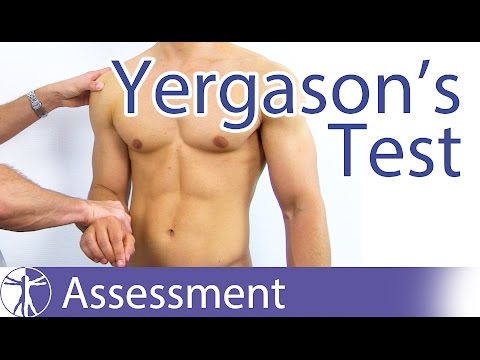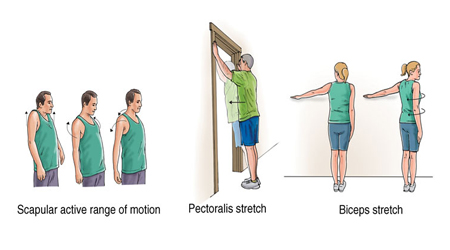Biceps tendonitis is inflammation in the long head of the biceps tendon that attaches the top of the biceps muscle to the shoulder. Pain in the front of the shoulder and weakness are common symptoms of biceps tendinitis. The most common cause is overuse of certain types of work or sports activities. The tendon may further become inflamed in response to other difficulties in the shoulder, such as rotator cuff tears, impingement, or shoulder instability.
Pain in front of the shoulder and weakness is the common manifestation of biceps tendinitis. They can often treat by rest, medication with your physiotherapist will use pain relieving techniques such as joint mobilizations, UST therapy, deep friction massage to assist you during this pain-full phase. In extreme cases, surgery may require repairing the tendon.
Causes of Biceps Tendonitis
In most instances, damage to the biceps tendon is because of a lifetime of normal activities. Our tendons slowly weaken with everyday wear and tear when we aged. Overuse can worsen this degeneration- repeating the same shoulder motions again and again.
There are many factors that may lead to biceps tendinitis, including:
- Continuous or repetitive shoulder actions can cause overuse of the biceps tendon. This is common in activities that require frequent and repeated use of the arm, especially when the arm motions are performed overhead.
- Weakness in the rotator cuff and muscles of the upper back.
- Degeneration of a tendon produces a loss of the healthy arrangement of the collagen fibers that join together to form the tendon.
- Shoulder muscles tightness
Rotator cuff tears, osteoarthritis, and chronic shoulder instability are often caused by overuse.
Symptoms of Biceps Tendonitis
Bicep tendonitis and tendinopathy sufferers will commonly report-
- Patients generally report the feeling of a deep ache directly in the front and top of the shoulder, located over the bicipital groove, occasionally radiating down to the elbow.
- Pain is usually made worse with overhead activities, especially those positions that combine abduction and external rotation. The pain is also aggravated by shoulder flexion, forearm supination, and elbow flexion.
- Some patients describe muscle weakness and an occasional snapping sound or sensation in the shoulder movements.
- The symptoms are relieved by rest and ice.

Bicep Tendonitis Diagnosis
Bicipital tendinopathy diagnosis is suspected by your physiotherapist or doctor based on your symptoms, history and a clinical examination. Tenderness to palpation over biceps groove. This makes it difficult to differentiate from the pain that is secondary to the shoulder impingement, the rotator cuff tear, or cervical disk disease. The pain of biceps tendinitis usually worsens at night, particularly if the patient sleeps on the affected shoulder. Ultrasonography(can show thickened tendon within bicipital groove) and MRI(can show thickening and tenosynovitis of proximal biceps tendon) are the best investigations to confirm the diagnosis.

Yergason’s Test –pain worsen in biceps groove when the patient tries to actively supinate against examiner resistance with elbow flexed to 90-degrees and the forearm in the pronated position.
Treatment of Biceps Tendonitis
Nonsurgical Treatment of Biceps Tendonitis
Treatment usually begins by resting the sore shoulder. The sport or activity that led to the problem is avoided.
Apply cold packs(wrap with the towel) for 20 minutes at a time, several times a day, to keep swelling down.
Anti-inflammatory medicine may be prescribed to ease pain and to help patients return to normal activity. Drugs like ibuprofen and naproxen reduce pain and swelling.

Steroids such as cortisone are particularly efficient anti-inflammatory medicines. Injecting steroids into the tendon can reduce pain. Your physician will use these carefully. In some incidents, steroid injections may further weaken the injured tendon and cause it to tear. Steroid injections usually only have an effect for a few weeks and your pain may come back if you stop the exercises.
A physical therapist will focus on restoring normal motion to your shoulder. Specific stretching and strengthening exercises can help restore range of motion and strengthen your shoulder.
Surgical Treatment of Biceps Tendonitis
Patients who are improving with conservative treatments do not typically require surgery, Surgery should be considered if conservative measures fail after three months. A biceps tenotomy may be implemented to eliminate the ruptured biceps tendon from the glenohumeral joint, and tenodesis may be avoided without significant loss of arm function. Biceps tenodesis is a process of reattaching the top end of the biceps tendon to a new position. Tenotomy is the procedure of choice for inactive patients 60 years and older with a ruptured biceps tendon.

